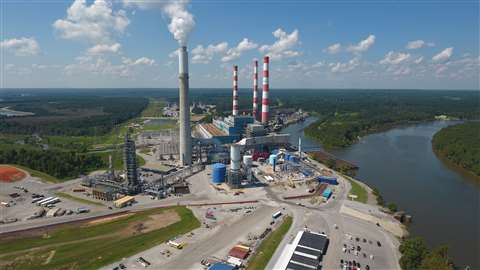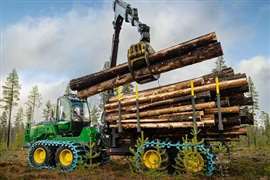EPA proposes GHG emissions standards for power plants
11 May 2023
Brings carbon capture technology into play
U.S. Environmental Protection Agency (EPA) proposed its first limits on greenhouse gas emissions for coal and natural gas-fired power plants.
The regulations would likely require power plants to use carbon capture technology, which is not widely available commercially.
“By proposing new standards for fossil fuel-fired power plants, EPA is delivering on its mission to reduce harmful pollution that threatens people’s health and wellbeing,” said EPA Administrator Michael S. Regan. “EPA’s proposal relies on proven, readily available technologies to limit carbon pollution and seizes the momentum already underway in the power sector to move toward a cleaner future. Alongside historic investment taking place across America in clean energy manufacturing and deployment, these proposals will help deliver tremendous benefits to the American people—cutting climate pollution and other harmful pollutants, protecting people’s health, and driving American innovation.”
 The U.S. Environmental Protection Agency (EPA) proposed limits on greenhouse gas emissions from coal- and gas-fired power plants for the first time.
The U.S. Environmental Protection Agency (EPA) proposed limits on greenhouse gas emissions from coal- and gas-fired power plants for the first time.
According to the EPA, the proposed limits and guidelines would require ambitious reductions in carbon pollution based on “proven and cost-effective control technologies” that can be applied directly to power plants. The agency also said the proposal provides owners and operators of power plants with ample lead time and substantial compliance flexibilities, allowing power companies and grid operators to make long-term planning and investment decisions. EPA’s analysis found that power companies can implement the standards with a negligible impact on electricity prices, well within the range of historical fluctuations.
The proposed rules will lead to higher costs and more risk of power shortages, industry members said. America’s Power, a national trade organization that advocates for the coal industry, issued the following statement by Michelle Bloodworth, President and CEO:
“Coal power plants are one of our most dependable and affordable sources of electricity. Unfortunately, EPA’s proposed carbon rule is at least the third rule EPA has issued within less than two years that is designed specifically to cause the premature closure of coal power plants. The proposal raises a number of critical legal questions, including whether EPA has the authority to force the use of technologies that are not economically or technically feasible for widespread use. One of the consequences of prematurely retiring coal plants is to exacerbate the risk of power outages. It makes no sense for EPA to propose a rule to shut down more coal plants one week after all four commissioners from the Federal Energy Regulatory Commission (FERC) testified before the Senate Energy Committee that coal plants are needed to maintain grid reliability. In addition to FERC, grid operators and the North American Electric Reliability Corporation have issued warnings for more than two years about the potential for electricity shortages due to the retirement of coal plants and other dispatchable electricity sources. We strongly urge EPA to modify the proposal to avoid premature coal retirements, rather than speed up retirements and jeopardize grid reliability.”
The standards EPA is proposing include:
- Strengthening the current New Source Performance Standards (NSPS) for newly built fossil fuel-fired stationary combustion turbines (generally natural gas-fired)
- Establishing emission guidelines for states to follow in limiting carbon pollution from existing fossil fuel-fired steam generating EGUs (including coal, oil and natural gas-fired units)
- Establishing emission guidelines for large, frequently used existing fossil fuel-fired stationary combustion turbines (generally natural gas-fired)
Based on a separate analysis, EPA is projecting the proposed standards for existing gas-fired plants and the third phase of the NSPS could achieve up to 407 million metric tons of CO2 emission reductions. As EPA works to finalize the rulemaking, the agency will complete additional advanced modeling, aligning methodologies across the rulemaking and considering real-world scenarios within the power sector to best understand how components of the rule impact each other.
As required by section 111 of the Clean Air Act, these proposed standards and emission guidelines reflect the best system of emission reduction (BSER) that has been demonstrated to improve the emissions performance of the sources, taking into account costs, energy requirements, and other factors. In developing these proposed carbon pollution standards, EPA considered a range of technologies including CCS, utilizing low-GHG hydrogen, and adopting highly efficient generation technologies.
Installation of controls such as CCS for coal and gas plants, and low-GHG hydrogen co-firing for gas plants are more cost-effective for power plants that operate at greater capacity, more frequently, or over longer time periods. The proposed standards and guidelines take this into account by establishing standards for different subcategories of power plants according to unit characteristics such as their capacity, their intended length of operation, and/or their frequency of operation.
The proposal requires that states, in developing plans for existing sources, undertake meaningful engagement with affected stakeholders, including communities disproportionately burdened by pollution and climate change impacts, as well the energy communities and workers who have powered our nation for generations. President Biden’s Interagency Working Group on Coal and Power Plant Communities and Economic Revitalization has identified historic resources for energy communities to invest in infrastructure, deploy new technologies that can help clean up the electric power sector, support energy workers and spur long-term economic revitalization.
EPA will take comment on these proposals for 60 days after publication in the Federal Register. EPA will also hold a virtual public hearing and will make additional information available on the website. Registration for the public hearing will open after the proposal is published in the Federal Register.
POWER SOURCING GUIDE
The trusted reference and buyer’s guide for 83 years
The original “desktop search engine,” guiding nearly 10,000 users in more than 90 countries it is the primary reference for specifications and details on all the components that go into engine systems.
Visit Now
STAY CONNECTED




Receive the information you need when you need it through our world-leading magazines, newsletters and daily briefings.
CONNECT WITH THE TEAM













